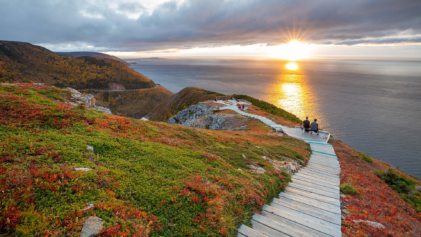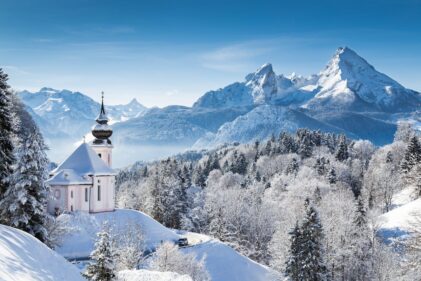Europe is a continent that has it all: from ancient ruins and world-famous art museums to breathtaking natural wonders and vibrant cities. Whether you’re a history buff, a foodie, or an adventure seeker, there are countless reasons to visit Europe. Here are ten irresistible reasons to explore the best of the Old Continent:
- Rich History: Europe is a treasure trove of history, with countless monuments, museums, and landmarks that date back to ancient times. From the Colosseum in Rome to the Parthenon in Athens, there’s no shortage of awe-inspiring historical sites to explore.
- Vibrant Cities: Europe’s cities are famous for their unique blend of history, culture, and modernity. Whether you want to stroll the romantic streets of Paris, party in Berlin, or admire the architecture of Barcelona, there’s something for everyone.
- Beautiful Landscapes: From the snow-capped peaks of the Alps to the sun-kissed beaches of the Mediterranean, Europe offers a stunning variety of landscapes. Hiking, skiing, swimming, or simply admiring the view, there are endless ways to experience Europe’s natural beauty.
- World-Famous Art: Europe is home to some of the world’s most famous art museums, including the Louvre in Paris, the Prado in Madrid, and the Uffizi in Florence. Whether you’re a fan of classical or contemporary art, you’ll find plenty to inspire and delight.
- Culinary Delights: Europe is a food lover’s paradise, with a rich and diverse culinary tradition that spans the continent. From French croissants and Italian pizza to Spanish tapas and Belgian chocolate, there’s no shortage of delicious dishes to try.
- Festivals and Events: Europe is home to some of the world’s most iconic festivals and events, from the Venice Carnival to Oktoberfest in Munich. Whether you want to dance the night away at a music festival or witness a historical reenactment, there’s always something happening in Europe.
- Wine Regions: Europe is home to some of the world’s most famous wine regions, from the rolling hills of Tuscany to the vineyards of Bordeaux. Whether you’re a wine connoisseur or just enjoy a good glass of vino, a tour of Europe’s wine regions is a must.
- Adventure Sports: Europe is a playground for adventure seekers, with opportunities for skiing, hiking, cycling, and water sports. Whether you want to climb a mountain, ride the rapids, or explore an underground cave system, Europe has it all.
- Shopping: Europe is a shopper’s paradise, with a diverse range of products and styles to suit every taste and budget. From designer boutiques in Paris to flea markets in Berlin, you’re sure to find something special to take home.
- Diversity: Europe is a continent of incredible diversity, with over 40 countries and dozens of languages spoken. Whether you want to immerse yourself in the culture of a single country or explore the rich tapestry of European cultures, there’s something for everyone in Europe.
In conclusion, Europe is a destination that offers endless possibilities for adventure, culture, and discovery. From the stunning landscapes and rich history to the culinary delights and world-famous art, there’s something for everyone in Europe. So why not start planning your next European adventure today?
Most visited places in Europe
Europe is a diverse and richly historical continent, attracting millions of tourists every year. Here are some of the most visited places in Europe:
- Paris, France – The City of Love is one of the most visited cities in Europe, known for its romantic charm, world-class art museums, and iconic landmarks like the Eiffel Tower and Notre-Dame Cathedral.
- Barcelona, Spain – With its unique architecture, sandy beaches, and vibrant nightlife, Barcelona is a popular destination for tourists from all over the world.
- Rome, Italy – As the capital of the ancient Roman Empire, Rome is known for its rich history and stunning landmarks like the Colosseum and the Pantheon.
- Amsterdam, Netherlands – Amsterdam is a picturesque city famous for its canals, museums, and relaxed atmosphere. Visitors also come to enjoy the famous Dutch tulips and the Red Light District.
- Berlin, Germany – The capital of Germany is a city that has reinvented itself since the fall of the Berlin Wall. Berlin has become a hub for art, culture, and history with its many museums, galleries, and landmarks like the Brandenburg Gate.
- Venice, Italy – Known as the city of canals, Venice is one of the most unique and romantic cities in Europe, with its gondolas, historic bridges, and ornate architecture.
- London, England – As the capital of the United Kingdom, London is a bustling metropolis that attracts visitors with its iconic landmarks like Big Ben, Buckingham Palace, and the Tower of London.
- Athens, Greece – Athens is the birthplace of democracy and the cradle of Western civilization, with its ancient landmarks like the Acropolis and the Parthenon.
- Prague, Czech Republic – With its well-preserved Gothic and Baroque architecture, Prague is a city of charm and culture, offering visitors a chance to explore its many museums and historic landmarks.
- Vienna, Austria – Vienna is known for its grand imperial architecture, classical music, and coffeehouses. Visitors come to explore the city’s many palaces, museums, and the famous Vienna Opera House.
These are just a few of the many popular destinations that Europe has to offer, each with their unique charm and attractions.
Best views in Europe
Europe is home to some of the world’s most stunning landscapes, from snow-capped mountains to crystal-clear lakes and turquoise seas. Here are some of the best views in Europe:
- The Swiss Alps – The majestic peaks of the Swiss Alps offer some of the most breathtaking views in Europe, with snow-capped mountains, glacier-fed lakes, and picturesque villages.
- The Amalfi Coast, Italy – The rugged coastline of southern Italy’s Amalfi Coast is dotted with colorful villages and offers stunning views of the Mediterranean Sea.
- The Northern Lights, Norway – The aurora borealis, or northern lights, is a natural light display that can be seen in the Arctic regions of Norway, Finland, and Sweden. The dancing lights of green, blue, and pink are a truly unforgettable sight.
- The Cliffs of Moher, Ireland – The towering cliffs of Moher rise up to 700 feet above the Atlantic Ocean, offering breathtaking views of the rugged Irish coastline.
- The Matterhorn, Switzerland – The iconic Matterhorn peak is one of the most recognizable mountains in the world, and offers spectacular views of the surrounding Swiss Alps.
- The Greek Islands – The crystal-clear waters of the Aegean Sea surrounding the Greek Islands offer stunning views of white-washed villages, sandy beaches, and ancient ruins.
- The Norwegian Fjords – The steep cliffs and crystal-clear waters of the Norwegian fjords offer some of the most spectacular scenery in Europe, with dramatic waterfalls and glaciers.
- The Plitvice Lakes, Croatia – The Plitvice Lakes National Park in Croatia is a UNESCO World Heritage Site, with crystal-clear lakes and waterfalls set against a backdrop of lush green forests.
- The Eiffel Tower, Paris – The iconic Eiffel Tower in Paris offers stunning views of the city, especially at night when the tower is lit up.
- The Spanish Steps, Rome – The Spanish Steps in Rome offer breathtaking views of the city’s rooftops and landmarks, including the Colosseum and the Vatican.
These are just a few of the many incredible views that Europe has to offer, each offering a unique and unforgettable experience.
European Geography
Europe is a continent located in the Northern Hemisphere, bordered by the Arctic Ocean to the north, the Atlantic Ocean to the west, and the Mediterranean Sea to the south. It is the second-smallest continent, with an area of approximately 10.18 million square kilometres.
Europe is home to a diverse range of landscapes, from mountain ranges and valleys to coastal plains and beaches. The continent is divided into several regions, including:
- Western Europe – This region includes countries such as France, Germany, the United Kingdom, and Spain, and is known for its diverse cultures, rich history, and modern cities.
- Eastern Europe – This region includes countries such as Poland, Russia, and Ukraine, and is known for its stunning architecture, historic landmarks, and unique cuisine.
- Southern Europe – This region includes countries such as Italy, Greece, and Portugal, and is known for its sunny beaches, crystal-clear waters, and charming villages.
- Northern Europe – This region includes countries such as Norway, Sweden, and Finland, and is known for its rugged landscapes, snow-capped mountains, and northern lights.
Europe is also home to several mountain ranges, including the Alps, Pyrenees, Carpathians, and the Scandinavian Mountains. The continent’s highest peak is Mont Blanc, located in the Alps, with an elevation of 4,810 metres.
Europe is crisscrossed by several major rivers, including the Danube, Rhine, Seine, and Thames, which have played an important role in the continent’s history and development.
Overall, Europe’s diverse geography and rich history have made it a popular destination for tourists from all over the world, offering a unique blend of culture, natural beauty, and urban sophistication.
European Cuisine
European cuisine is as diverse and varied as the continent’s geography and cultures. From hearty German sausages to delicate French pastries, there’s something to please every palate. Here are some of the most famous and beloved dishes from around Europe:
- Italian Pizza and Pasta – Italy is famous for its delicious pizza and pasta dishes, with thin crusts and a variety of toppings and sauces.
- French Croissants and Cheese – France is known for its buttery croissants and a wide variety of cheeses, including brie, camembert, and roquefort.
- Spanish Paella and Tapas – Spain is known for its flavorful paella, a rice dish with seafood, meats, and vegetables, as well as tapas, small plates of savoury dishes like chorizo, olives, and anchovies.
- German Sausages and Beer – Germany is famous for its sausages, including bratwurst and weisswurst, and its wide variety of beer styles.
- Greek Moussaka and Souvlaki – Greece is known for its savoury moussaka, a layered dish of eggplant, minced meat, and béchamel sauce, and its delicious souvlaki, skewered meats often served with pita bread and tzatziki sauce.
- British Fish and Chips – Britain is famous for its crispy, battered fish and chips, often served with mushy peas and tartar sauce.
- Swedish Meatballs and Gravlax – Sweden is known for its delicious meatballs, often served with lingonberry sauce, and its smoked salmon dish, gravlax.
- Hungarian Goulash – Hungary is famous for its hearty goulash, a stew of beef, onions, and paprika, often served with dumplings or bread.
- Polish Pierogi – Poland is known for its delicious pierogi, boiled or fried dumplings stuffed with fillings like potato and cheese or meat and sauerkraut.
- Portuguese Pasteis de Nata – Portugal is famous for its custard tarts, pasteis de nata, crispy pastry shells filled with creamy custard.
These are just a few examples of the many delicious and varied dishes found throughout Europe. European cuisine is truly a treasure trove of flavours, traditions, and culinary delights.
What’s the Weather like in Europe?
The weather in Europe can vary widely depending on the region and the time of year. Generally, Europe has a temperate climate, with warm summers and mild winters in many parts of the continent. However, there are some areas with more extreme weather conditions, such as the Arctic regions of Scandinavia and the hot, dry summers of the Mediterranean.
In Northern Europe, countries such as Norway, Sweden, and Finland have cold, snowy winters with temperatures often dropping below freezing. Summers are generally mild, with temperatures ranging from the mid-60s to low 70s Fahrenheit (around 18-22 degrees Celsius).
Central Europe, including countries such as Germany, Austria, and Switzerland, experiences a temperate climate with four distinct seasons. Winters can be cold, with snowfall in some areas, while summers are warm and pleasant, with temperatures ranging from the mid-70s to low 80s Fahrenheit (around 23-28 degrees Celsius).
Southern Europe, including countries such as Spain, Italy, and Greece, has a Mediterranean climate, with hot, dry summers and mild, rainy winters. Summers can be very hot, with temperatures often reaching the mid-90s Fahrenheit (around 35 degrees Celsius) or higher.
Coastal areas in Europe generally have more mild temperatures than inland areas, and many cities experience moderate temperatures throughout the year.
It’s important to note that weather conditions can vary widely even within the same region or country, so it’s always a good idea to check the weather forecast before travelling and to pack accordingly.
When is the best time to visit Europe?
The best time to visit Europe depends on what you want to see and do, as well as your personal preferences for weather and crowds. Here are some general guidelines for the best times to visit Europe:
- Summer (June-August): Summer is the peak tourist season in Europe, with warm weather and long daylight hours. However, this also means bigger crowds and higher prices, especially in popular destinations. If you’re planning to visit beaches, go hiking or explore outdoor activities, summer is an ideal time.
- Spring (March-May): Spring is a great time to visit Europe, as the weather is mild and the crowds are smaller than in summer. This is also the time when flowers and trees bloom, making for beautiful scenery. However, weather can be unpredictable and it can still be chilly in some areas.
- Fall (September-November): Fall is another good time to visit Europe, with mild weather and fewer tourists. The fall foliage can be stunning, especially in countries like Germany and Austria. However, some attractions may have shorter hours or be closed during this time.
- Winter (December-February): Winter can be a magical time to visit Europe, with Christmas markets and winter sports activities. However, it can also be cold, dark, and wet in many parts of the continent. If you’re planning to visit ski resorts, this is the best time to go.
Overall, the best time to visit Europe depends on your interests and priorities. Consider the weather, crowds, and activities you want to do before planning your trip. Additionally, be aware that some attractions and accommodations may be closed during the low season.
european culture
European culture is a rich tapestry of history, art, literature, music, food, and traditions. It encompasses diverse cultures, languages, and religions, with a long and complex history that has influenced the world in countless ways. Here are some of the key features of European culture:
- Art and Architecture – Europe is home to some of the world’s most famous art and architecture, from the Renaissance masterpieces of Italy to the Gothic cathedrals of France and Spain.
- Literature – European literature has produced some of the most influential writers in history, including William Shakespeare, Dante Alighieri, Miguel de Cervantes, and Jane Austen.
- Music – European classical music has a rich history, with composers like Beethoven, Mozart, and Bach producing some of the world’s most iconic pieces.
- Fashion – European fashion has been at the forefront of global trends for centuries, with designers like Chanel, Dior, and Versace influencing the industry.
- Food – European cuisine is known for its diversity and quality, with each region offering unique dishes and ingredients. Some of the most famous culinary traditions include French cuisine, Italian pasta and pizza, and German sausages and beer.
- Festivals and Traditions – Europe is home to a wide range of festivals and traditions, from the famous Carnival in Venice to Oktoberfest in Germany, and Christmas markets in many cities.
- Sports – European sports culture is deeply ingrained, with football (soccer), rugby, and cricket being popular in many countries.
- Languages – Europe is home to over 200 languages, with many countries having their own official language. However, English, French, Spanish, German, and Italian are among the most widely spoken.
- Religion – Christianity has been a major influence on European culture, with the Catholic and Protestant churches having played significant roles in shaping the continent’s history and values.
Running Watch Buyer’s Guide: Track Your Progress with the Right Device

Uncovering the Beauty of Stockholm: A Scandinavian Gem
Breaking the Stigma: Promoting Mental Health Awareness in Society
The Ultimate Running Shoe Buyer’s Guide: Find Your Perfect Fit
A Taste of Tuscany: Exploring Florence, Siena, and Chianti
The Role of Nutrition in Promoting Healthy Sleep
Triathlon Bike Buyer’s Guide: Selecting the Right Ride for Speed and Comfort

A Guide to the World’s 10 Best Beaches
Supporting Loved Ones with Mental Health Challenges: 10 Tips for Caregivers
Hydration Gear Buyer’s Guide: Stay Fuelled and Hydrated on the Move

A Journey Through the Scottish Highlands: Majestic Landscape
10 Beginner-Friendly Yoga Poses for a Healthy Start to Your Practice
The Pros and Cons of Running Alone vs. Running with a Partner

Cape Winelands: Indulging in South Africa’s Finest Wines
The 5 Ways Meditation and Mindfulness Improve Sleep Quality
Unveiling the Secret to Lasting Happiness: 7 Proven Strategies for a Fulfilling Life
7 Common Cycling Injuries: Causes, Symptoms, and Treatment
10 Tips to Prevent Common Cycling Injuries and Ride Safely
Choosing the Right Gear for a Triathlon: 8 Essential Triathlon Gear Tips for Success
The Delights of Prague’s Christmas Markets: Festive Magic in the Czech Republic

A Historic Sojourn: Discovering Colonial Williamsburg

Lost in the Megalopolis: Navigating Asian Metropolises
The Tea Trails: A 5 Step Journey through Asian Tea Cultures
The Power of Probiotics: How These 7 Gut-Boosting Heroes Bolster Your Health and Immunity
Natural Skincare Secrets: 7 Tips for Radiant and Healthy Skin
Mindfulness and Resilience: How Mindfulness Can Help Build Resilience in the Face of Adversity
The Benefits of Trail Running: Why You Should Give It a Try

Experiencing the Northern Lights in Iceland: A Natural Wonder
Sleep Disorders in Children: Recognizing and Managing Common Issues
The Benefits of Compression Clothing in Preventing and Recovering from Injury
How to Balance Swimming with Running and Cycling in Triathlon Training
Swimming for Rehabilitation: How Swimming Can Help You Recover from Injuries
How to Stay Motivated with Running: 10 Strategies for Consistency and Accountability
Tips for Proper Bike Fit to Prevent Injuries and Maximize Performance

Discovering the Stunning Fiordland National Park, New Zealand: Exploring Nature’s Masterpiece

Discovering the Stunning Fiordland National Park, New Zealand: Exploring Nature’s Masterpiece
Sossusvlei: Capturing the Dramatic Dunes of Namibia
The Magnificent Cinque Terre: Coastal Beauty in Italy

Exploring the Greek Islands: Santorini, Mykonos, and Crete
Understanding the Gut-Brain Connection: Gut Health and Mental Wellbeing
The Role of Sleep in Athletic Performance and Recovery: 5 Reasons Why a Good Night’s Rest is Crucial for Athletes
7 Yoga Poses for Calming the Mind and Reducing Stress
How to Plan the Perfect Family Vacation: 10 Expert Tips for an Unforgettable Getaway

10 Essential Tips to Prepare for a Long-Haul Flight

A Guide to the World’s Most Beautiful Waterfalls: Discover the Natural Wonders
10 Essential Pieces of Protective Clothing for Open Water Swimming
7 Essential Facts Open Water Swimmers Need to Know About Jellyfish
The Power of Strength Training: 5 Ways It Enhances Your Triathlon Swim Performance
South America’s Hidden Treasures: 10 Spectacular Gems Waiting to be Discovered
The Art of Herbal Tea Blending for Health and Wellness
The Ultimate Guide to Effective Treatment for ADHD: 10 Proven Strategies to Thrive with Attention Deficit Hyperactivity Disorder
How to Determine if You Have ADHD: 8 Key Signs to Look Out For
How ADHD is Diagnosed: A Comprehensive Guide
Is It OK to Only Use Yoga for Exercise? 5 Key Points to Consider
Can Yoga Help with Weight Loss?? 7 Ways Yoga Can Transform Your Body
How Often Should I Do Yoga? Find the Perfect Balance for Your Practice
The Different Types of Swimming Strokes: Which One is Right for You?
Road Trip to the Rockies: Exploring Colorado’s Scenic Highways
5 Hip-Opening Yoga Poses for Greater Flexibility and Reduced Tension
7 Effective Strategies to Boost Your Cycling Endurance for Long-Distance Rides

Cruising the Amazon: Wildlife and Wonder in South America
The Power of Warrior II Pose: Strengthening Legs and Core Muscles
The Science Behind Runner’s High: What You Need to Know
The 10 Most Impressive Archaeological Sites to Visit Around the World
Bedtime Routine: 10 Techniques for Preparing the Mind and Body for Sleep
10 Reasons Why Swimming is the Best Form of Exercise

The 10 Best Destinations for a Thrilling Skiing or Snowboarding Trip
7 Steps to Master the Challenging Headstand Pose in Yoga
Running in Different Seasons: Tips for Hot, Cold, and Rainy Weather
10 Tips for Staying Healthy While Traveling: Your Guide to a Fit and Happy Journey
Understanding Mindful Gardening: Techniques for Finding Peace and Joy in the Garden
How to Choose the Right Paddleboard for Your Needs

10 Essential Tips for Travel Photography: Capture Memorable Moments Around the World

The Top 5 Destinations for Photography Enthusiasts
5 Restorative Yoga Poses for a More Relaxed and Restful Sleep
The Importance of Proper Breathing Techniques in Swimming

The 10 Best Travel Apps to Download for Your Next Adventure
Mindfulness and Relationships: 7 Techniques for Improving Communication and Connection
The 5 Best Foods for Runners: Fueling Your Body for Optimal Performance

The Top 5 Destinations for Scuba Diving
Mindfulness and Productivity: How Practicing Mindfulness Can Boost Your Focus and Efficiency
Top 10 Kayaking Destinations in North America
A Beginner’s Guide to Backpacking in Europe
The Science Behind Cat-Cow Pose: 5 Benefits for Spinal Health
Paddleboarding vs. Kayaking: Which is Right for You?
5 Common Triathlon Injuries and How to Prevent Them
10 Tips and Tricks to Overcome Mental Blocks in Running
How to Choose the Right Swim Gear: 7 Tips for Beginners
The Ultimate Guide: 5 Key Differences Between Kayaking and Canoeing
7 Kayaking Mistakes to Avoid: Ensure a Safe and Enjoyable Adventure
Sit-In vs. Sit-On Kayaks: Which Style is Right for You?
What to Wear When Kayaking: 7 Essential Gear for a Safe and Comfortable Adventure
Do You Need a Wetsuit for Kayaking? 7 Reasons Why It’s Essential
Fueling for Triathlons: 10 Tips for Optimal Performance
Top 10 Triathlon Races to Add to Your Bucket List

Sustainable Travel: 10 Ways to Reduce Your Carbon Footprint While Exploring the World
10 Must-Visit Destinations for Nature Lovers
ADHD Causes: Understanding the Risk Factors
Mindfulness and Pain Management: How Mindfulness Can Help Manage Chronic Pain
How to Train for Your First 5K: A Step-by-Step Guide


















